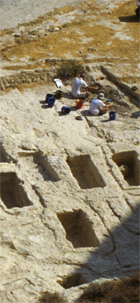The Phases of Kourion's Amathous Gate Cemetery
Hellenistic Material and Monumental Wall
The architectural remains from Trench TrA01, close to the Amathous Gate, are the earliest and most impressive on the site. They consist of a stretch of what seems to be a fortification wall c. 3m long and 1.6m wide. The foundation consists of two layers: packed rubble below; and on top of it six large flat stones closely fitted on the faces surrounding a rubble core similar in nature to the first layer. Two rough blocks with traces of plaster facing placed vertically and slightly inset from the foundation survive in situ, and a third is displaced to the side.
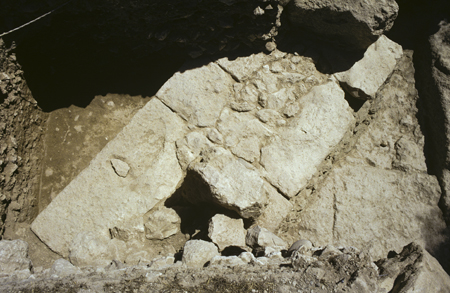
Excavated stretch of monumental wall in Trench A1
While only a short stretch is exposed, it is clear that the wall turns a corner at its southwestern end, moving away from the gate, perhaps to incorporate an interior courtyard or a small room flanking the actual entrance to the city some 15m to the southwest. The type of construction matches that seen in the Hellenistic fortification walls on the opposite side of the city in the vicinity of the Paphos Gate.
We also have extensive residual Hellenistic material in a range of deposits across Areas A and B, including pottery, glass, terracotta figurines and lamps.
Chamber tombs
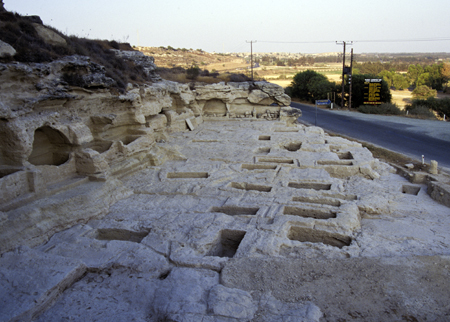
Arcosolia and cist graves at the east end of Area B
One of the most striking aspects of the southeastern approach to the city would have been the line of chamber tombs visible halfway up the scarp, appearing as a series of doors and tomb markers overlooking the plain. Other than the rear arcosolia (rock-cut sarcophagi surmounted by arches) and some of the side arcosolia, little of these tombs remains, due to quarrying operations in the 4th century CE.
The arcosolia on the eastern side of Area B (see plan) give the best idea of the layout of these tombs. The tomb they belonged to clearly had three arcosolia along the eastern side, presumably matched by another three on the western side, since quarried out, and another at the rear (north) of the tomb. The dimensions of this tomb, including the arcosolia and the doorway, were c. 8.0 x 3.5 m. There are two libation pipes in the chamber for mourners to pour wine to the dead, as well as traces of the doorway and a rock cut entrance platform at the south end.
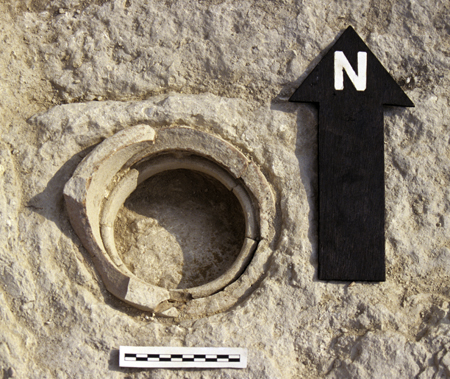
Libation pipe in Area B, Trench TrB04
To visit the cemetery, mourners would leave the city by the Amathous Gate and turn left onto the cemetery road going past Area A and then past the entrances and tomb markers of the seven chamber tombs in Area B (see map). These are classic cases of what Parks referred to as ‘a tomb with a view’, overlooking the plain and the sea, with the shadowed doorways being very striking to travellers from a substantial distance. The mourners would then turn sharp left into a narrow defile, and almost immediately turn right again into another defile between the cliff and a limestone ridge (Area C). This was lined on both sides with tomb entrances and associated markers. It would have strongly resembled a city street, with the houses of the dead on each side. After 50 m the defile opens out into a broader area with chamber tombs on each side (Area D).
In spite of the minimal numbers of intact deposits associated with the chamber tombs and their extensive destruction by quarrying in the 4th century CE, the surviving evidence still allows us to reconstruct the funerary landscape of Early Roman Kourion. It is clear that the dead played a prominent role among the living: the mourners would walk along the cemetery road to visit a specific tomb or tombs, and enact a series of rituals, in particular the pouring of wine as offerings to the deceased.
Dump
One of our most exciting discoveries was a very large deposit of discarded material, immediately outside the Amathous Gate (Trench TrA01). This is an intact deposit, and it is clear from the pottery and coins that it dates to the 1st–3rd centuries CE. Although it may represent debris from the destruction of the chamber tombs, it could also be the dumped remains from public or funerary dining. Particularly striking are the fragments of preserved plaster mouldings and fresco fragments showing garlands executed in greens, reds and yellows. These show close parallels with fresco fragments from the Acropolis, both the Earthquake House and public buildings in the Agora. The worked stone includes a 21 cm high limestone incense burner, an altar, and fragments of marble revetment slabs, which could also derive from a public building.
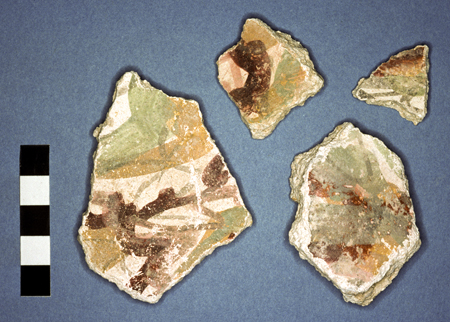
Fresco fragments from the ‘dump' in Area A
Small finds include lamp fragments dating mainly to the 1st–3rd centuries CE, bronze coins, and fragments of glass bowls, beakers and ungentaria. The large number of animal bone fragments consist mainly of sheep/goat, pig and cow, with substantial numbers of butchered pieces, particularly cow. Most of the fine ware pottery dates to the 2nd century CE and perhaps the beginning of the 3rd. It mainly consists of bowls, plates and kraters. It is particularly interesting that the fine wares make up just 9% of the total pottery. This makes it very unlikely that the dump is a domestic assemblage. There is an impressive number of deep, globular cooking pots and and shallow open casseroles, perhaps suggesting a large-scale kitchen for producing very specific types of meals.
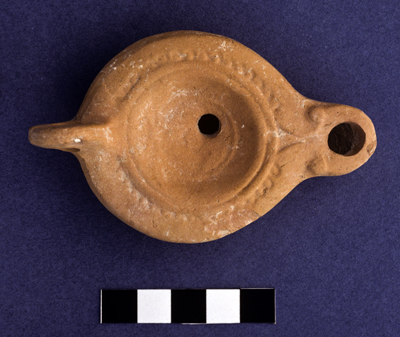
1st century CE lamp from the ‘dump’ in Area A
The pottery and animal bones suggest that large-scale dining was an important feature of the cemetery, while the frescoes and architectural fragments suggest that there was substantial display involved. Public and funerary dining are well-known phenomena in the Roman world. It is tempting to envisage some sort of monumental building, with large-scale kitchens and decorated dining rooms for banquets in honour of the dead.
Quarrying
The landscape of the Amathous Gate Cemetery was radically transformed in the later 4th century C.E. The chamber tombs were demolished, and the limestone into which they were cut was systematically quarried out. Only the rear arcosolia of the tombs were left in place, giving a striking series of shadowed arches round the edge of the level quarry floor in Area B.
The Kourion Acropolis is composed of two strata of limestone: the lower one is hard and grey, and the upper soft and yellow, and often very weathered. Only the lower grey stratum was worth quarrying. By the time it had been well-exploited by the builders of the chamber tombs, there was not a large amount of material left for the quarrymen of the later 4th century CE. It is likely that this quarrying was a response to the great earthquakes of that century, possibly associated with reconstruction efforts.
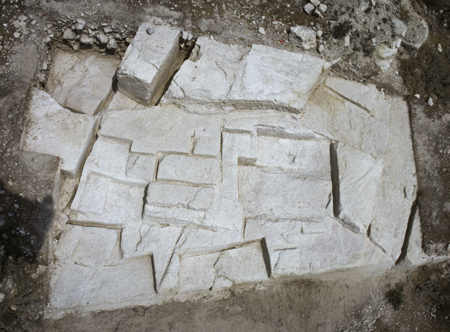
Quarrying in Area A
We excavated an extensive quarrying complex in Area A, which shows how the quarrying was carried out. The quarrymen worked on a stepped quarry face, cutting slots along the back and sides of the intended block using a quarry pick with a 1 cm-wide blade. Small horizontal slots were then cut along the base at the front of the block. The blocks were split off by hammering iron wedges into these horizontal slots, or perhaps by soaking wooden wedges with water to make them expand. The upper surfaces show characteristic ‘billows’ where they were split away from the parent rock. The typical block size across the quarrying remains in Areas A, B and C is 110 x 45 x 35 cm.
Cist Tombs
In the late 4th–6th centuries CE, a series of simple cist graves was dug into the relatively level floor left by the quarrying (see plan). We recorded 70 of these graves and excavated 26. Their average dimensions are 192 x 84 cm, and they are typically 75–85 cm deep, with a rock-cut ‘headrest’ at one end. They were covered by limestone slabs, and have a complex system of drains to allow the run-off of rainwater.
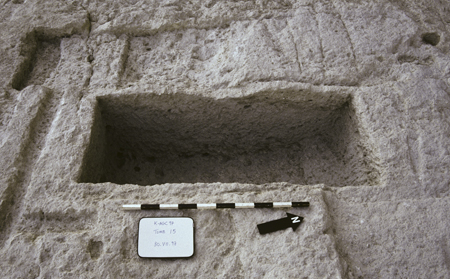
Tomb B15, with headrest at right
Although most of them were heavily disturbed, some preserved partially intact deposits, and one was totally undisturbed. Grave goods included personal and funerary jewellery, coins, lamps, glass bowls and unguentaria, and a few cooking pots.
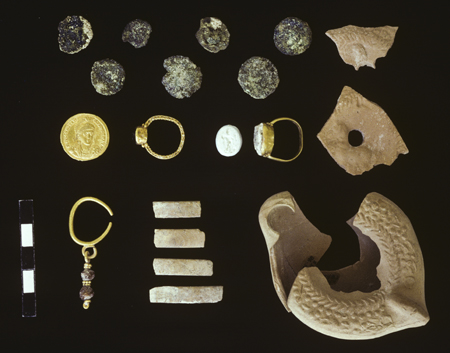
Burial assemblage from Tomb A1 cist grave
By the time these graves were cut, this was for the most part a Christian landscape. There were exceptions, of course. The church fathers were still combatting pagan practices into the 6th and 7th centuries, and the popularity of pagan mythology in the mosaics of the grand urban villas on the Acropolis suggest a continuing pagan commitment.
Many of the grave goods found in the cist graves are entirely consistent with Christian practices. This most obviously applies to the jewellery, which is all personal jewellery such as rings, beads and earrings, rather than funerary jewellery such as diadems, wreaths and mouthpieces made specially for the ceremony. Similarly there is a considerable decrease in pottery and in paraphernalia for anointing the deceased.
Some of the grave goods, however, suggest continuing pagan practices. Half of a large cooking pot was found in Tomb B15 next to the crania of two adults, its charred bottom indicating it had been used (see photo). Tomb B21 contained four casseroles. This suggests that there was still some form of funerary meal or offering of food to the deceased. The intact cist grave in Area A had a libation pipe set into its lid and a small plain ware jar with a hole in the bottom, also clearly for libations. This is another example of an originally pagan custom that was incorporated into early Christianity at Kourion.
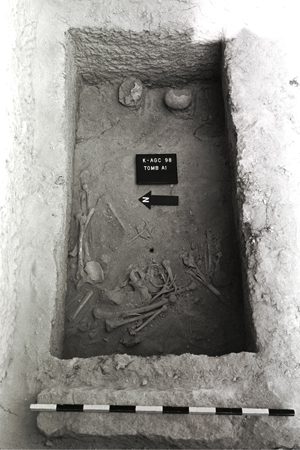
Tomb A1 with bones in situ
The human remains from the cist graves were particularly well-preserved and significant. We identified at least 111 individuals, showing pathologies such as osteoarthritis, healed fractures, possible cribra orbitalia, and some developmental defects. Dental health is generally good. Analysis of inherited traits in the teeth suggests that the cist grave cemetery was organised according to kinship groups. This is very much in keeping with the emphasis on family relationships that appears in the epitaphs and documentary evidence.
Facetting
One of the most visually striking features of the Amathous Gate Cemetery is the way the Acropolis cliff has been cut into a series of vertical facets or scallops. It is clear that this is a separate operation from the quarrying. There are no slots or outlines of blocks; many of the sections are quite sharply curved; most of the stone is soft and, in terms of building material, highly inferior. The dating is not clear, but it is most likely to belong to the same period as the quarrying in the late 4th century CE.
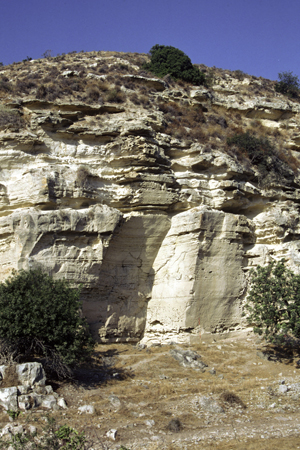
Facetting in Area F. Height of cliff is c. 18 m
The facetting on the western side of Area F is the most impressive of the whole Kourion Acropolis (see map). The Acropolis rock here is over 30 m high, and the smooth, elegant facets and scallops reach the top. Although much of the soft yellow limestone is very weathered, the toolmarks can still be seen in many areas, with the characteristic herringbone pattern produced by successive blows first one way, then the other.
The rockcutters clearly respected what remained of the chamber tombs after the earlier quarrying operation, normally just the rear arcosolia. At the west end of Area B the facets are usually aligned close to the back of the arcosolia, just showing their outline. In Area D they are aligned with the front of the arcosolia, so that the shadowed arches are visually very striking in the smoothly cut rock face.
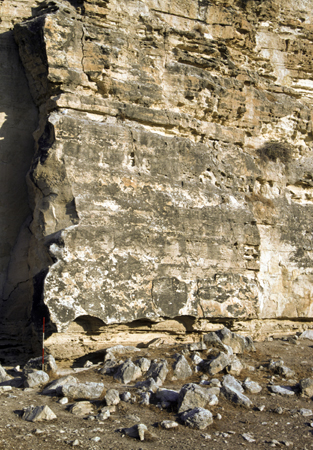
Facetting which exposing the rear arcosolia of earlier chamber tombs, Area D
The whole vast operation gives the air of being improvised as the stonecutters worked their way round the cliff, making use of faults, accommodating arcosolia, and in general sculpting the cliff into a pleasing set of facets and curves which are enhanced and highlighted by the morning sunlight. In practical terms, the end result is a vertical cliff, and so the aim may at least in part have been defensive. Given the care that the stonecutters bestowed on the operation, however, it is clear that the aesthetic role of the facetted cliffs was also highly significant. Many other Late Roman urban fortifications incorporated reused architectural elements as reminders of the city’s past; in the case of Kourion, those elements consisted of the arcosolia of the chamber tombs.
Lime Kiln
In the north-east corner of Area A, right against the Acropolis cliff, we excavated the remains of a small lime kiln. It is built against the facetted rock, which shows burning from the kiln, and so it so clearly post-dates the facetting. Other lime kilns on the Acropolis date to the period after the Arab invasion, and this may well be contemporary.
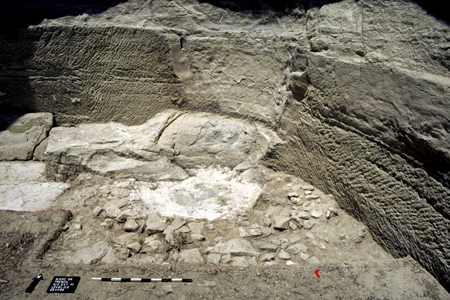
Lime kiln
The kiln consists of a circular plaster floor c. 1.20 m in diameter. Irregular flat stones form a border around the floor, and the Acropolis rock has been hollowed back to complete the circle. Strong burn patterns delineate the edges of the kiln, both in the Acropolis rock and the soil surrounding the stone border, indicative of the high temperatures achieved in the kiln. Scattered charcoal deposits also attest to the kiln activity.
Finds included a striking number of marble and limestone fragments, clearly intended as fuel for the kiln. These included the head from an Archaic horse figurine, the limestone lid from a cist grave, and chips of different varieties of marble, particularly Proconnesian marble, which was popular in the 2nd century CE.
The kiln provides interesting evidence of the changing use of space: the area outside the Amathous Gate was transformed from a place for burial and ritual to a productive/industrial space. A similar phenomenon has been noted at Paphos, where the former Roman suburban funerary landscape was redeveloped in Late Antiquity for pottery production, and thus became part of that city’s productive landscape.


